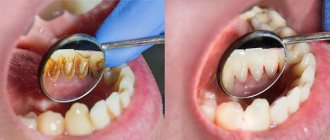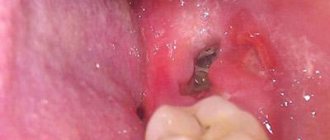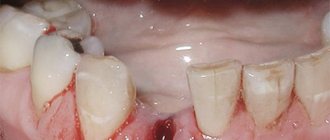From this article you will learn:
- why does a tooth hurt after pulpitis treatment,
- what to do if a tooth hurts after pulpitis treatment,
- What are the complications after treatment of pulpitis?
Pain after treatment of pulpitis can in some cases be natural, and also be the result of gross mistakes by the dentist. Here we should cite indicative official statistics - in 60-70% of cases, pulpitis is treated poorly, which leads to various complications and tooth loss.
After treatment of pulpitis, it is mandatory to take a control x-ray, which shows how well or poorly the filling was done. However, statistics show that seeing the shortcomings of the treatment performed in the control image, most dentists do not seek to redo the poor-quality work.
Indications for nerve removal
- Caries has reached the pulp. Initially, caries appears on the enamel, then moves to dentin, then to the pulp. Inflammation increases: acute pain occurs. To eliminate the pain and save the tooth, you need to remove the nerve.
- Injuries of various types: impact, fracture, chip. With such mechanical impact, traumatic pulpitis develops. The integrity of the tooth is damaged, the infection penetrates into the pulp. Inflammation occurs and pain appears. Treatment involves removing the nerve.
- Retrograde infection. When inflammation occurs at the apex of the tooth root, it then spreads to the nerve.
- Orthopedic treatment. Before placing a crown, in some clinical cases it is necessary to remove the nerves. To avoid complications, a severely damaged tooth is first treated: the nerves are removed.
- Asymptomatic pulpitis (chronic). The patient does not have acute pain, but the nerve is infected. The patient's complaints may include mild pain in the past.
What are the methods for removing a nerve?
- Amputation . This method is rarely used: mainly in pediatric dentistry. Its essence lies in the fact that the neurovascular bundle is partially removed. The pulp remains in the roots, and only the coronal part is removed. In adults, it is used in exceptional cases, when the doctor sees that the inflammation has affected only a small part of the nerve.
- Extirpation . The pulp is completely removed from the tooth. After removing the nerve, the canals are cleaned, washed, and filled.
How many nerves are there in a tooth?
Different teeth differ from each other not only in their location in the oral cavity, shape and functions (chewing, incisor, canine), but also in their internal structure, number of roots and canals. The deeper a tooth is in the mouth, the more canals and roots it has, and most of them are in the teeth of the upper jaw.
But the number of nerves located inside a tooth may not depend on the number of canals and roots - for example, in the same tooth, different people may have one single nerve, or two, or even three (mostly again, in the far teeth, seven, six and eight). All of them are visible only during the X-ray procedure - that is why, before treating caries or, especially, pulpitis, an X-ray of the tooth
is mandatory. The doctor needs to know how many nerves there are in a particular tooth, and how badly they are damaged; depending on this, a decision will be made about their removal or treatment.
Removing the nerve of a tooth is a procedure that most dentists try to avoid until the last minute. However, it is not always possible to preserve the nerve and pulp, and here’s why.
Sequence of treatment
- Diagnostics . After the doctor has examined you and collected your medical history, an X-ray is taken. This diagnosis allows you to evaluate the structure of the tooth and plan treatment. To see the full anatomy of the root canals, a computed tomography (CT) scan is performed - a 3D diagnostic that allows you to see all the structures of the tooth.
- Pain relief . Local infiltration or conduction anesthesia is performed. Before the injection, the gums are lubricated with an anesthetic gel so that the injection is not felt.
- Setting up insulation . Root canal work should be done in clean, dry conditions. For this purpose, rubber dam (insulation) is used. It is a latex plate that is placed on the tooth. Advantages of isolation: saliva and plaque do not enter the root canals. Medicines and solutions also do not flow into the patient’s mouth.
- Preparation of hard dental tissues . The doctor uses a drill to remove the destroyed tissue. To prevent overheating of the tooth, water flows from the tip. The doctor creates direct access to the root canals.
- Nerve removal . It is performed with thin sterile instruments similar to long needles. The doctor places an instrument into the root canal and removes the nerve. Machine rotary tools may also be used. This stage is completely painless, since anesthesia was previously performed.
- Mechanical and medicinal treatment of canals . The canals are washed with special antiseptic solutions and passed through with instruments. This allows you to completely remove the diseased nerve and relieve inflammation.
- Temporary filling . Root canal work is complex, so it is not always possible to treat a tooth in one visit. An anti-inflammatory paste is placed into the canals, a temporary filling is placed, and a further stage of treatment is planned.
For permanent restoration of the crown part of the tooth, ]esthetic dentistry[/anchor] will be required.
Contraindications
Doctors at the SDent aesthetic dentistry center collect all data about the patient’s condition before starting treatment. In the health questionnaire, the patient notes the characteristics of his body, and the doctor conducts a survey. Planned nerve removal is not performed if:
- high blood pressure, hypertensive crisis;
- first, third trimester of pregnancy (provided there is no acute pain);
- acute inflammatory diseases of the mucous membranes and facial skin;
- acute respiratory and viral diseases, etc.
General recommendations after treatment
- You can eat and drink immediately after treatment;
- Until the anesthesia wears off, you should not eat rough food;
- in the days following treatment on the side of the diseased tooth, do not chew rough, hard food;
- in some cases, anti-inflammatory drugs, painkillers, and oral baths are prescribed;
- If a temporary filling falls out, consult a doctor immediately;
- If pain occurs after placing a temporary filling, also consult a doctor immediately.
After the anesthesia wears off, the patient may feel discomfort in the area of the treated tooth. If pain, throbbing, or swelling occurs, you should consult a dentist.
How to relieve pain
If a tooth hurts severely after treatment of pulpitis, taking a pain reliever (Analgin, Ibuprofen, Ketolac, etc.), rinsing the mouth with an antiseptic solution or a warm herbal decoction of lemon balm, sage, oak bark, chamomile, will help temporarily relieve the pain symptom and alleviate the condition. calendula.
It is strictly forbidden to heat a sore tooth, apply alcohol or garlic compresses to the gums, or take antibiotics or aspirin.
Long-term consequences after treatment
Patients often experience complications after nerve removal. This is due to many factors: lack of diagnosis, poor quality treatment, incorrect diagnosis, etc. Main consequences:
- poor canal filling. A loose filling leads to the re-emergence of bacteria that extend beyond the tooth root. A cyst forms, due to which the tooth is often removed;
- tool fragments. The complex anatomy of the canals and low-quality instruments can lead to its failure.
- removal of material beyond the root apex. If the filling material is chosen incorrectly or there is too much of it, it extends beyond the root.
- Tooth perforation occurs due to aggressive processing.
To avoid such complications, doctors at the SDent clinic recommend contacting us for medical help, as we have a staff of highly qualified doctors, an equipped X-ray room and advanced equipment!
Why does a tooth hurt after removing a nerve from a tooth?
Pain after treatment of pulpitis can be minor or acute. The appearance of pain can be associated with injury (to a lesser extent), but most often with the development of inflammation.
Trauma to tissues in the area of the apex of the tooth root –
Since the treatment involves the removal of the inflamed pulp (neurovascular bundle) and filling the root canals, it is quite reasonable that minor pain may occur due to the following:
- During the process of pulp removal, the neurovascular bundle is detached at the level of the apex of the tooth roots,
- Instrumental treatment of the root canals was performed. During this process, the tips of the instruments, extending slightly from the root canal beyond the root apex, can injure the tissue in the area of the root apex.
- The root canals were treated with medication by rinsing them with antiseptics. Antiseptic agents can enter in small quantities outside the root canals - into the tissue at the root apex. Because Since dentistry uses very strong antiseptics, they can actually have an irritating effect.
If the tooth was filled correctly, then the toothache after removal of the nerve lasts 1-3 days and disappears.
Poor quality root canal filling –
Poor quality treatment is indicated primarily by symptoms: pain, swelling of the gums. But very often inflammation can develop unnoticed, and then it can only be determined by an x-ray. There are several main signs of poor-quality root canal filling, which you can even independently determine from an x-ray after reading this article.
Signs of poor-quality root canal filling:
- Root canals are not filled to the root apex – Let us recall that pulpitis is an inflammation of the dental pulp associated with the ingress of microorganisms into it. During the process of pulp removal, canal expansion, and medicinal treatment, a certain amount of microflora in the canal, of course, remains. And if the canal is not filled up to the apex of the root or is poorly obturated with filling material (not tightly filled, there are pores), then the infection will multiply in its lumen throughout the unsealed section of the canal.
This infection will enter the tissue surrounding the tooth through an opening at the apex of the root. As a result, a so-called periodontal abscess (purulent sac) will appear at the root apex. This disease is called periodontitis.In Fig. 1-2 you can see radiographs of teeth after unsuccessful treatment of pulpitis. White arrows indicate unfilled areas of the root canals. Black arrows mark the areas where the periodontal abscess is localized (on an x-ray it looks like intense darkening at the root apex).
In Fig. 3 you can see how well-filled root canals should look on an x-ray. Black arrows show the places where the tops of the roots end (up to which the canal should be sealed).
What to do if the root canals are not filled to the root apex: it is necessary to completely re-treat the tooth, and the sooner the better, before inflammation at the root apex leads to tooth loss. To do this, you need to unfill the root canals and fill them again (24stoma.ru). There is also a surgical treatment method that can be used if the root canal is poorly sealed only at the very apex of the root, but the rest of the canal is well sealed. In this case, you can perform a resection of the apex of the tooth root. In this case, there is no need to remove the crown or unfill the canals.
- The filling material is brought out beyond the root apex – if during the process of filling root canals the filling material is removed beyond the apex of the root, this can also cause pain. In Fig. 4-5 you can see radiographs in which the filling material is clearly visible, extended beyond the root apex. The black arrows in Fig. 4-5 show the apexes of the roots (normally, the root canal is filled no further than this point). White arrows show the removed excess filling material (in Fig. 4 this is gutta-percha, and in Fig. 5 this is filling paste).
What to do if the root canals are filled: the issue is resolved individually. If a small amount of material is removed, the pain may subside quickly enough, and in this case there is no need to re-treat the tooth. In extreme cases, the tooth may hurt for up to 1-2 months. The decision about whether to wait two months for the pain to subside can be made based on the dynamics of pain. If the pain is not acute and it gradually decreases, then it is quite possible to do without re-treatment of the tooth.
If a large amount of material is removed, then surgical treatment may be required, which will also involve resection of the root apex. In this case, a hole is made in the bone in the projection of the tooth roots, through which excess filling material is removed. The operation is not very complicated, it lasts about 30-40 minutes.
- Breakage of an instrument in the root canal - during mechanical treatment of the root canal, or during the process of filling it - the instruments used for this may break in the root canal. In some cases it is possible to get them, in some cases, for example, if the tip of the instrument breaks in the apical third of the root, it is not possible to get such fragments. To a greater extent, this is the fault of doctors who violate the technique of using instruments. An exception may be cases where the root canals are severely curved. Naturally, such a fragment will not allow the root canal to be completely sealed, and this will lead to the proliferation of infection in the unsealed part of the canal and the subsequent development of inflammation in the tissues surrounding the tooth. In Fig. 6-8 you can see fragments of instruments in the root canals.
- Perforation of the tooth root – in the process of instrumentation of root canals and screwing pins into them, perforation may occur. Perforation is a “non-physiological hole” in the root wall, which is made by a doctor (Fig. 11). Perforations are one of the most difficult problems in dentistry. Their occurrence is most often associated with medical negligence. But sometimes they arise for objective reasons, for example, when the root canals are excessively curved.
In Fig. 9-10 you can see radiographs that show perforations of the tooth root that were made when installing pins in the root canals. The root canals are straight and not curved, which suggests that in both cases this was an illiterate work of the doctor. In both cases, the pins are inserted through the root wall directly into the bone tissue. In both images, intense shading (limited by black arrows) can be seen in the area of perforations, which indicates the development of a periodontal abscess.Perforations can be predictable when working in highly curved, narrow, difficult to navigate root canals. In this case, it is sometimes almost impossible to perform high-quality instrumental processing of such channels. And this sometimes happens even to very good doctors. But when the channels are “statistically average”, then the occurrence of perforation is associated, as a rule, only with a doctor’s error.
What to do in case of perforations: this pathology is very difficult to correct. To close perforations, special expensive materials are used, for example, Pro-Rut. If perforation occurs due to the fault of the doctor, the clinic is obliged to provide such treatment at its own expense. Filling with Pro-Ruth can be done in some cases both conservatively (from inside the tooth) and (in some cases) using surgical access to the perforation.
Read about quality standards in root canal filling in the article: → “Root canal filling standards”











